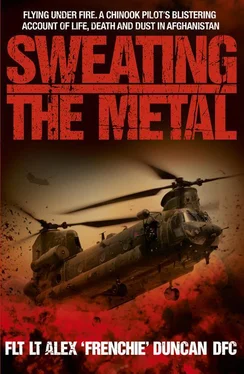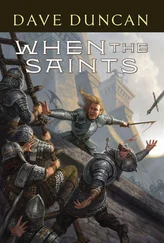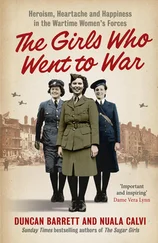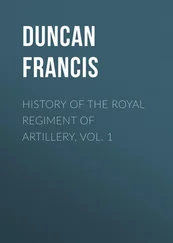‘Ramp up, clear above and behind,’ says Griz, so I pull in maximum pitch, nose down and we disappear, leaving the Marines to it. The two we’ve got on board are in a bad way, but both will go on to survive; one has extensive burns, the other has had a traumatic amputation of his lower leg. Their dead colleague was the Viking’s driver, Marine Dale Gostick.
However, we still need to get them back to the safety and assistance of the hospital at Camp Bastion, which means flying along the Sangin Valley again. We’ve been lucky once; can we ride our luck a second time? Speed and low altitude are our best defences, so I wring all available power from the cab as I route us over the Russian trenches on the west side of the wadi – not only is it the most direct track back to Bastion, but it also has the benefit of being the most difficult point for the enemy to get a bearing on us from.
As soon as we’re over open desert, I ask the medics if they’re happy for me to climb, and get the reassuring message that both casualties are stable and time isn’t an issue. I pull in the power and the cab responds to my input on the collective, taking us up to altitude. We arrive back at the sanctuary of Nightingale HLS at Bastion without incident.
As it transpires, Dale Gostick and the other two Royal Marines we lifted were returning to base on the last operational day of their tour. Six months of fighting, six months of risk and fear and depravation, six months of worry for their families, and on the last day one dies and two incur life-changing injuries. It makes no sense, but the thought comes anyway: so near and yet so far .
I can’t help thinking about the impact these injuries have on the guys that are out on the front line, fighting on our behalf. Imagine you’re a Royal Marine. You’re fitter than a butcher’s dog, at the absolute peak of human endurance and fitness. These guys can run up mountains without breaking a sweat, they undertake triathlons for fun, and their bodies are testament to all that man is capable of. They’re like machines; the complete antithesis of the average aircrew with our soft bodies, pampered existence at KAF and two-month tours.
The guys at the front take their fitness for granted. Just like the two in the back of my cab who got up this morning and probably went through the same routine that they’ve done every morning in theatre. Suddenly, in less time than it takes to read this sentence, their lives are ripped apart and changed forever. Having to learn to walk on one, maybe two, prosthetic legs; the long road back to fitness after months in Selly Oak and Headley Court; wasted muscle, torn bodies, all the upheaval and heartbreak. How do you come back from that? Your athlete’s body is now broken and wracked with pain. And then there’s the guilt of surviving when your best mate and oppo has died.
It’s funny how some things strike you more than others, but all of us were particularly concerned about the two Marines, so I wandered over to the hospital after dinner to seek an update on their condition. What really lifted me was the knowledge that both patients were as high as kites on morphine, and not only conscious, but had spent most of the evening flirting with the nurses and taking the piss out of one another’s injuries. I felt buoyed up on the walk back to the IRT tent.
That sortie marked my last kinetic op on the Det, although it was also the third op since I was shot down that involved my aircraft taking fire. After that, my nickname of Frenchie was temporarily replaced by the equally apposite ‘Bullet Magnet.’
My feet rested on my body armour as I sat opposite JP in the crew tent. We’d been chatting for some time, but to be honest, I didn’t hear much after he said what basically amounted to, ‘Ah, Mr Duncan; for you, the war is over.’ On the conclusion of our last sortie on that day, May 28th, my crew and I would fly back to KAF to await our flight home. But before we left, he had one more surprise up his sleeve: our final mission would be an air test.
Air tests are a routine part of life when you’re at KAF – we take airframes that have had major work done on them and fly them out over the Red Desert to give them a full work up, basically ensuring that all major systems are functioning as they should and that there are no minor gripes that could impact on a sortie once the aircraft is signed back in to fly the line.
Of course when I signed for the airframe that we were to test, I was more than a little surprised to discover that it was ZD575, the one we’d been shot down in, on its first test before return to service. After I’d unceremoniously landed her at FOB Edinburgh, a few engineers had flown forward from KAF to perform emergency repairs on her in situ. Once they ensured she was safe to fly, the aircraft was flown back to KAF for the major work and repairs to be undertaken. I’d been given the honour of taking her up and signing her off.
As expected, the sortie went without a hitch – the airframe looked as good as new, the hydraulics were faultless and she handled sublimely. Responsive as ever, she flew as smooth as a baby’s bottom and performed with alacrity. After completing the various tests so that I could sign her off with confidence, I said to the crew, ‘Right, that’s the air test finished. Let’s go and have some fun!’
I flew a couple of wing overs and then a thought occurred to me: I want to take some of Afghanistan home with me; let’s land in the Red Desert .
‘Let’s go and see what these dunes are really like,’ I said over the intercom, and I picked out a particularly big one and landed right on top of it. Griz filled a couple of empty water bottles with its fine-grain, iron-rich sand and, with that, we were away. Some of that sand now sits proudly on the mantelpiece at home (now in a fine glass container rather than a grotty old plastic water bottle!)
There seemed to be some serendipity at work with my starting and finishing the Det in ZD575; in a way, things had come full-circle for me. I must admit, when I shut her down on the deck at FOB Edinburgh – after limping home with a chunk of the rotor missing and the hydraulic system out of action – I wondered when I might see her again. The opportunity of nursing her back into service, fully functional and good as new after her spell with the engineers, was a nice end note to my time in theatre and a safe, non-kinetic mission to wind down with.
A few minutes before I left the departure lounge at KAF to board the aircraft home the following night, our Squadron boss at 27 Sqn walked in. Wing Commander (now Group Captain) Dom Toriati came over to see me, having just arrived in theatre. After seeking out JP, he walked over to me and reached out to shake my hand. As he did so, he looked me in the eye and said, ‘You lucky, lucky bastard, Frenchie!’ I’m sure what he was actually thinking was: ‘Thank fuck you didn’t lose the squadron an aircraft, because the paperwork would have been a nightmare!’
Either way, it was a nice moment because I felt a genuine sense of relief on his part, a touching concern that we had all got away unharmed from the attempt to shoot us down. I daresay he had a sleepless night when news of what had happened filtered through to him back at RAF Odiham in the immediate aftermath of the event. All joking aside, the paperwork and headaches that the loss of an aircraft generates would have been astronomical, and however much it shouldn’t, something like that follows you around your whole career. Obviously, because of his role as Squadron boss, Toriati is quite remote from the minutiae of day-to-day life, but it was nice that he showed such concern. I wished him the best of luck as he started his four-month staff tour in theatre, and with that we were on our way home.
Читать дальше













